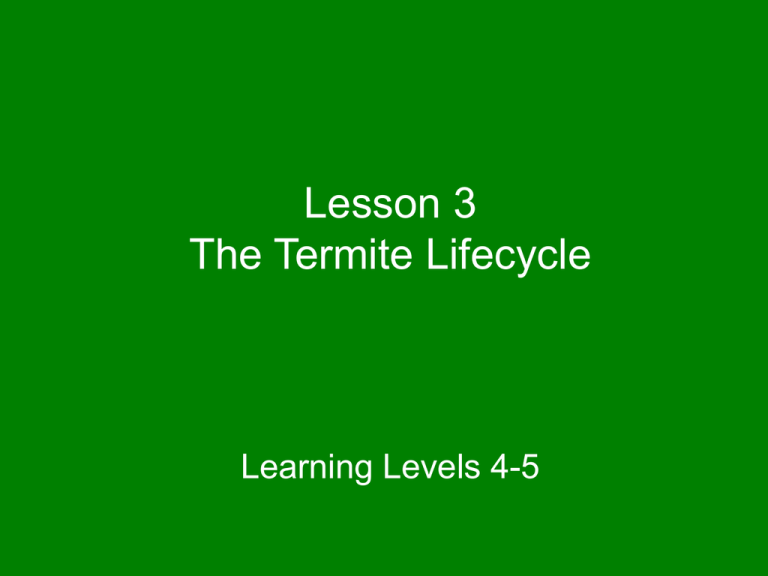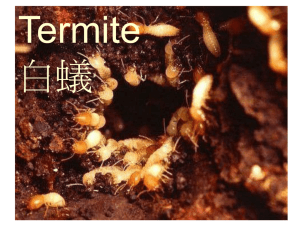(Ter)mighty Memories - Moanalua Middle School
advertisement

Lesson 3 The Termite Lifecycle Learning Levels 4-5 What is a lifecycle? A lifecycle traces the stages of an animal’s life from birth through growth and development into adulthood when the animal begins reproduction, starting the lifecycle over. Lifecycles are important to scientists who study animals. A lifecycle can tell them many details about the animal’s biology, ecology and development that could be useful in helping to increase that animal’s chances for survival or in the case of pest species like termites, decrease their chances for survival. Starts Over Ending Beginning The lifecycle of a termite is unique in that it does not just tell the lifecycle story of one individual insect, but tells the story of the birth and development of the entire termite colony. Stage 1 Alates Leave Colony Stage 1: Major Events 1. Alates leave the colony through aboveground flight slits made in a piece of wood by workers. 2. The job of the alates during this stage is to find a mate. 3. They use their wings and eyesight to find the nearest light source and a potential mate…this process is called swarming. 4. Swarming happens on windless, humid nights near dusk. 5. Major swarming takes place AprilJune, but small swarming can take place anytime during the year. 6. Swarming typically lasts only 30 minutes. 7. Not all alates in a single colony must swarm on the same night; they mature and leave at different times. Stage 2 Now that the Alates have found their mate, they must move onto finding their new home in stage 2…. Stage 2 Start of New Colony Stage 2: Major Events 1. Once alates have paired off, they drop to the ground and break off their wings by folding them back against a natural crease near the base. 2. After alates loose their wings they are called dealates. 3. The job of the alates during this stage is to find a place to begin a colony. With the female leading they search for food, water and a suitable shelter. 4. Out in the open alates are vulnerable to predators such as lizards, birds, amphibians and other insects. 5. Alates are the future Kings and Queens. The colony has now been started and it is time for the alates to transform into the royal couple in stage 3…. Stage 3 Stage 3 Alates Become the Royal Couple Stage 3: Major Events 1. Colony growth begins slowly. The Queen starts her egg production with only 15-20 eggs. 2. At about 5 years old the Queen is full grown and can produce 2,000 eggs per day! If a human mother was like the termite Queen she would be 60 ft. tall and could make enough babies to fill a baseball stadium everyday! 3. The job of the Queen and the King is to reproduce. 4. There can only be one King and Queen per termite colony. 5. The King and Queen do most of the reproducing until they become sick or die. 6. The average lifespan for the King and Queen is 15-20 years. The Queen is on her thrown and it is time to build the termite colony in stage 4…. Stage 4 Stage 4 Growth of Young Nymphs Stage 4: Major Events 1. Young termites are called nymphs. Nymph is a common term used for the young stages of insects. 2. Termites go through a growth process called simple metamorphosis. This means that the young termites look like the adult termite and only make slight changes as they grow. 3. During metamorphosis, the termite exoskeleton is shed and re-grown several times before they reach adulthood. 4. Once adult workers are present, they take over the role of caring for the young nymphs. 5. The workers will remove the eggs from the Queen’s chamber to a designated nursery area. 6. Scientists are unsure of how long it takes for a young termite to reach adulthood. Stage 5 The termite nymphs are growing and the colony is full of activity, its time for those nymphs to get their adult jobs in stage 5… Stage 5 Assignment of Colony Roles Stage 5: Major Events 1. The young nymphs have grown into older nymphs and are now ready to take on their adult colony roles. 2. The older nymphs perform small colony duties and help out in the nursery until the Queen is ready to transform them. 3. Scientists are unsure of the exact process by which the Queen transforms the older nymphs, but they know she uses chemicals similar to hormones. 4. The Queen uses chemical feedback from the colony to determine how many of each termite caste is needed at that point in time. Stage 6 The roles have been handed out and now it is time to get to work in stage 6… Stage 6 Perform Colony Roles Stage 6: Major Events 1. Workers, soldiers and reproductives are the 3 termite castes. 2. Workers are the most numerous. Their jobs include: digging tunnels, building carton, feeding and grooming other castes, foraging for food and taking care of the young nymphs. 3. Soldiers are less in number than workers with 1 soldier for every 10 workers in an average termite colony. The duty of the soldier is to protect the colony from intruders. 4. The reproductives occur in the smallest numbers, except for the times of year when swarming conditions are good. The duties of the reproductives are to start new colonies and maintain population numbers. Stage 7 Everyone is doing what needs to be done to make the colony a success so it’s time to look to the future of all termites and start the cycle all over again in stage 7… Stage 7 New Alates Form Stage 7: Major Events 1. The lifecycle completes itself and starts over when the alate nymphs once again mature and are ready to leave the colony. 2. When the conditions are right, the Queen will send out hormones that will help the alate nymphs mature into adult alates. 3. Alate nymphs remain immature until just before swarming takes place. The full transformation happens quickly. 4. Any adult alates that do not leave are not tolerated for long within the colony walls. 5. All alate nymphs may not mature at the same time, so swarming can happen in different rounds within the same colony. Thisincreases the chances of the alates finding a mate from another colony. Making Sense of the Termite Lifecycle The termite lifecycle is very involved and can take some time to learn. Practice piecing together the stages of the lifecycle with a group using the laminated puzzle pieces provided by you teacher. First match the label to the correct illustration and then place all the events in the proper order starting with stage 1. Good Luck!









